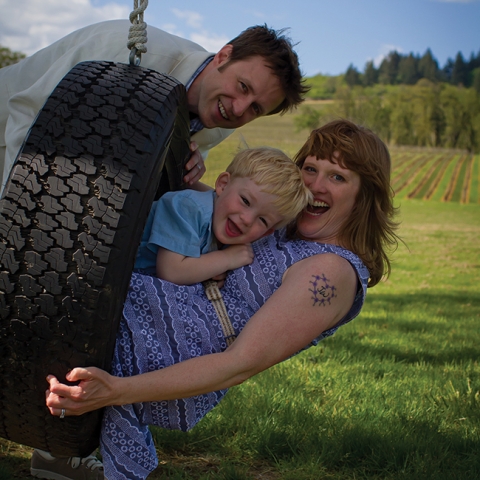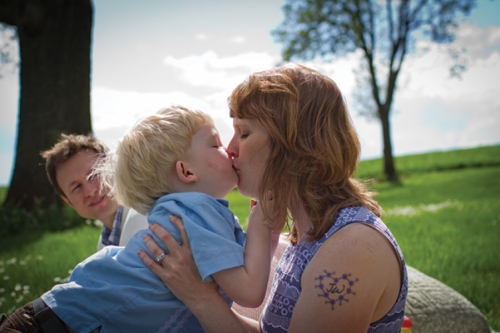In May 2010, stay-at-home mom Jill Wood learned that her two-year-old son Jonah had an extremely rare and fatal genetic disease called Sanfilippo Type C. For weeks, she was afraid to Google the illness because she’d been warned that would only upset her more. When she finally did, it confirmed her worst fears: a missing enzyme would allow toxic waste products to build up in Jonah’s brain, eventually robbing him of the ability to walk, talk, and see. There is no cure for Sanfilippo syndrome, and the only available treatment—cord blood transplant—carries a 20 percent mortality rate.
Devastated, Wood got into the shower and cried uncontrollably. Then, as she described it, she had an epiphany: she would start a foundation, she would find other options, she would save Jonah’s life.
“Once I accepted it, which didn’t take long, I realized Jonah was going to die if I didn’t do something about it,” Wood says. “What else was I supposed to do, stick my head in the sand? Sit around and cry? I don’t have time for that. I will cry—we have all done a lot of crying, of course—but I will cry when we don’t have a cure, and Jonah suffers brain damage. Right now, the clock is ticking.”
42,000 steps
Jill Wood and Jonah are in a race they never wanted to run. All too often, as research scientists try to turn discoveries into new treatments and cures, they feel like they’re running up Heartbreak Hill—a section of the Boston Marathon known for sapping runners of their energy and filling their legs with lead. Unfortunately, the race for new treatments and cures has more in common with the 42,000 steps in the Boston Marathon than with a quick neighborhood 5K.
Only 14 percent of medical research findings turn into beneficial clinical changes. And it can take up to seventeen years to turn a discovery into a treatment—a stretch of time some researchers call the valley of death. Few scientists attempt to cross it, and even fewer succeed.
“Under the best-case scenario, we can expect to have only one clinically relevant discovery in our whole lifetime as scientists,” says cardiologist Cam Patterson. “If we’re going to deal with the big problems we have in health care, like heart disease, cancer, and stroke, we’ve got to get out of this snail’s- pace approach to bringing discoveries to the bedside. Fortunately, we’re beginning to understand and address some of the hurdles that slow us down.”
Each researcher runs only a small portion of the race from bench to bedside, and there’s not always someone to pass the baton to. Many promising discoveries slow to a halt or fall off course. “Let’s admit it, sometimes we as researchers can get in a rut,” says John Buse, who directs the UNC Diabetes Center. “I spend my time doing clinical trials for diabetes. If I moved a little bit off of the reservation, I would definitely need help taking that next step.”
Buse is part of a new movement to help science keep on pace through translational research, an effort to get basic medical findings into practice more quickly and efficiently. The goal is to transform the way biomedical research is done so scientists can more easily take their breakthroughs to the finish line.
The National Institutes of Health has funded a consortium of sixty universities and medical centers, including UNC’s NC Translational and Clinical Sciences (NC TraCS) Institute, to the tune of $500 million. That money will give scientists training and infrastructure to pursue new methods to treat disease.
And they’re off
To get in the race, a scientist first needs a great idea. For surgical oncologist Nancy Klauber-DeMore, that idea came from wondering why the drug Avastin wasn’t killing tumors in her breast cancer patients like it was supposed to. The drug thwarts a molecule that stimulates the production of blood vessels that supply oxygen and nutrients to tumor cells. Yet only about one-third of patients respond to the drug, and of those who respond, almost all ultimately die from their cancer. (The FDA proposed withdrawing Avastin as a treatment for metastatic breast cancer in December 2010.)
DeMore thought the tumors might be bypassing the drug-induced roadblock and getting blood supplies through another route. So she looked for a gene she could manipulate to eliminate those alternative routes and stop the tumors from growing.
Almost immediately, DeMore encountered a roadblock of her own. The NIH rejected her grant application: her proposal was “not technically possible.” So she got funding from private foundations to develop the technique herself, dissecting microscopic blood vessels from normal and cancerous breast tissue and using gene-chip technology to look for genetic differences between the two types. That took three years.
“Of course I would want it to go faster,” she says. “Everyone would want it to go faster. But I think when you’re doing drug discovery, and you’re trying something that has never been technically possible, it’s going to take time.”
Next, DeMore generated a list of one thousand genes that could be drug targets, eventually placing all her bets on one called SFRP2. It took one year to prove that her star gene played a role in making new blood vessels, followed by another year to generate a molecular compound to block the gene in tumors, and six more months of animal testing. Now DeMore must modify the drug for human use before the biggest challenges yet: Phase I, II, and III clinical trials, which could take another nine years. If those succeed, she hopes to get FDA approval for her drug.
At every step along the way, DeMore must find more money. It takes data to get funding—but it also takes funding to get data. So NC TraCS and other institutions have created pilot awards to help scientists generate the data they need to get bigger grants more quickly and keep their projects on pace.
“The way the system is built, it can be a lot of hurry up and wait,” DeMore says. “There was a year when I’d finished my two NIH R01 grants and hadn’t gotten my next one yet, and a TraCS grant allowed me to continue my experiments and not have any delay in the science. It made a huge difference for my research.”
More hurdles ahead
Getting funding more quickly and easily is one way to accelerate research, but throwing more money at the problem won’t necessarily get medicines onto shelves faster. The NIH doles out $31 billion annually to support biomedical research. That’s more than double what it averaged each year in the 1990s. Yet the FDA approved only seventy-four new drugs from 2006 to 2009—half the number the agency approved in a comparable period a decade earlier.
There are other obstacles on the road to completing the marathon. Buse thinks basic scientists sometimes don’t consider the clinical implications of their research.
“We’re trying to get the basic scientists to come up for air from their benchtops, to talk to people in TraCS about what they’re working on and whether it’s something that is applicable to human health. And, if so, to get help moving it forward,” says Buse, who serves on NC TraCS’s steering committee. Howard McLeod, who has spent years researching the genomics of the body’s response to drugs, thinks another part of the problem lies in the link with clinicians. Doctors can be hesitant to leave the safety of standard treatments behind and explore new ways of treating patients, he says.
“To get things moving faster, we really have to create a new metric of success,” says McLeod, who’s one of many investigators helping to lead NC TraCS. “In the past, a lot of the extremely basic science has been done and published, and then you just hope someone accidentally does something with it. We can do better.”
One basic researcher who hadn’t considered translating her findings was Carol Otey—until she got an unexpected call from a clinician at the University of Washington (see Endeavors, Winter 2011, “Cold Called”). Teri Brentnall had found that some of her pancreatic cancer patients carried a mutation in a gene Otey had discovered. The two researchers figured out that having too much palladin, a protein that gives cells their shape, can cause cells to become contractile and stiff, boring channels through neighboring tissue and allowing cancer to metastasize and spread. After collaborating for seven years, Otey, Brentnall, and cancer surgeon H.J. Kim showed how palladin might be useful as a biomarker to spot early-stage pancreatic cancer, a type of cancer that often isn’t diagnosed until it’s too advanced to treat.
Hitting Heartbreak Hill
People facing life-threatening illnesses are among the most impatient for such breakthroughs. Jill Wood’s son Jonah may not survive the ten years it can take for a new treatment to traverse the FDA approval process. So his best chance is to enroll in a clinical trial.
But this is the spot where most scientists hit Heartbreak Hill.
Only 14 percent of clinical trials reach recruitment goals on time. That’s partly because it takes between 5,300 and 5,600 patients to get enough data to file for a new drug application with the FDA, and partly because there are about 100,000 clinical trials already in existence. UNC has one of only three Clinical and Translational Science Award sites in the country with an office dedicated to helping researchers identify, recruit, and retain the research participants they need to complete their clinical trials.
The Research Recruitment Office at UNC has helped more than fifty investigators, including clinical psychology doctoral student Carlye Kincaid, who tests the benefits of smartphone technology in supporting a parenting skills program. The Carolina Data Warehouse for Health, a repository of data on 1.8 million potential research subjects, helped Kincaid find the best participants for the study. Though Kincaid’s study is cruising along, other researchers continue to face challenges. Ken Ataga, for one, has been involved in a number of clinical trials for sickle cell disease, but these have yet to produce any new treatments.
“Because I’m more of a clinical researcher, new drugs don’t get to me until they’ve gone through all types of preclinical testing in petri dishes and animals,” Ataga says. “And not many drugs have crossed that barrier from preclinical to clinical. There have been a few, but not as many as I would want.”
Ataga was the lead investigator on a trial of an experimental drug that keeps the red blood cells of sickle cell patients well hydrated, under the hypothesis that the cells would be less likely to clump up and cause the painful, debilitating episodes that most patients experience. He saw the drug through promising results from Phase I and II trials, eventually presenting the results at a national hematology meeting. But then the trial’s Data and Safety Monitoring Board halted the Phase III study when it determined that the drug didn’t significantly decrease patients’ pain episodes.
“It was very disappointing,” Ataga says. “To go from the start to the end was very exciting, but unfortunately it didn’t pan out the way we had hoped. It’s a complicated disease, and unless we do the trial, we don’t know what’s going to work and what isn’t going to work. So we just have to keep trying.”
The final steps
The FDA was created to protect public health, so safety—not speed—is its top priority. But some researchers think the agency’s many restrictions may be doing patients more harm than good.
In 2010, an independent science board reviewing the FDA concluded that American lives are at risk because “while the world of drug discovery and development has undergone revolutionary change—shifting from cellular to molecular and gene-based approaches—the FDA’s evaluation methods have remained largely unchanged over the last half-century.”
The FDA responded with initiatives to change the way it reviews science and technology breakthroughs. The most recent of these is a plan to scientifically dissect the FDA’s methods and procedures and modernize them to ensure that effective products aren’t stuck in the pipeline.
UNC hematologist Thomas Fischer has sent many products into that pipeline. One of his inventions, a glass-laced bandage that stops bleeding two times faster than cotton ones, has been approved for both military and civilian applications.
“I haven’t hit on some of the horror stories you often hear about,” Fischer says. “The FDA has been very good to me. But I do know what the back door of the FDA looks like—that’s where I usually end up. But they’re very polite about it.”
Fischer’s bandage went from an idea to being FDA-approved in only eighteen months. In some ways he had a head start because he was working on a device, which doesn’t have to go through the same regulatory three-phase trial as pills or other therapeutics. But even working on devices, researchers can still wait years for approval.
The key to Fischer’s success was probably that he developed the new bandage under the auspices of Entegrion, a company he founded in 2002. His CEO quickly set him up with textile-industry scientists who could help him design the bandages and connect with private investors who had readily available capital. Without that, Fischer’s project would’ve taken years longer as his team waded through academic cycles of grant funding for their research.
“The kind of money we need to truly develop an invention is beyond the scale of our current funding mechanism,” explains Cathy Innes, director of UNC’s Office of Technology Development. “So if universities are lousy at development, it’s because it isn’t what we were set up to do. We have to find a way to get to the point where a company will invest, or start our own company.”
UNC currently spins out five to ten companies a year, but efforts are under way to triple or quadruple that number in 2012.
Carolina Kickstart, an NC TraCS program that helps scientists commercialize their discoveries by providing small grants, education, and mentoring, is working closely with the Office of Technology Development to do this.
“In the life science area, there are very few ways to translate discoveries and move them closer to the patient except through commercial means,” says Don Rose, Carolina Kickstart’s program director. “People are trying to understand what the return on the investment is for a particular technology or a particular line of research.”
Scientists can get a crash course in business through a class at UNC called Launching the Venture. Fischer took the course many years ago and says that the experience gave him the training he needed to start his business. And that business was critical when he faced the infamous gap from bench to bedside.
“That is a very real thing,” Fischer says. “I managed to get across it with one product, but I have many others to go. The trick there was to get across it fast, to take a gulp of water and run.”
The ability to try something new, to get out of your comfort zone, and even be willing to fail, is essential to translational medicine and to entrepreneurship. That’s something Cam Patterson learned when he started studying business.
“I didn’t go to business school thinking this would turn me into an entrepreneur. But one thing it taught me was that a lot of things I did on a day-to-day basis were entrepreneurial. I’d just never seen them that way,” says Patterson, who now codirects Carolina Kickstart with Rose. “And it made me realize that starting a company wasn’t something for only a small subset of individuals. If you have great ideas, you can push them forward.”
Patterson is partnering with DeMore to commercialize her basic discovery so it can help treat breast and other cancers. With guidance from Joel Schaffer, an entrepreneur-in-residence, they started a company called Enci Therapeutics to drive their invention into the marketplace.
“You get to the point where it’s very difficult to keep going, because you need large amounts of money the typical grant mechanism can’t cover, and yet pharmaceutical companies aren’t ready to partner with you,” DeMore says. “So how do you bridge that gap? My goal as a surgeon who treats patients with breast cancer is to take discoveries out of the lab and into the clinic. To me, it seemed like starting a company was the only option to get that done.”
Beyond the finish line
Once a medical discovery makes it through preclinical experiments, animal testing, clinical trials, and FDA approval, it will do little good if it just sits in the medicine cabinet or pharmacy. Yet there can be widespread variation in how a new drug or device, once on the market, is used clinically.
“It really comes down to communication,” says Joan Cates, who has studied ways to raise HPV vaccine awareness. “I think scientists need to communicate their findings in plain language long before those findings get into practice. The public doesn’t always know these treatments are out there.”
There are at least two parts of the race that even increases in infrastructure, grants, and manpower can’t touch. The first is human nature. Getting people to do what is best for their health is ultimately out of doctors’ hands.
The second is nature itself. Technology can speed up information acquisition and make conducting global and simultaneous experiments possible. But when it comes to grasping all of the nuances and subtleties of science that determine whether a treatment will work—well, scientists aren’t even close.
“I think the single biggest restriction is human ignorance of biology,” Fischer says. “It’s our intrinsic limitations as intelligent monkeys in understanding nature. It’s only been in the last several decades that medicine has done people any good in a statistical sense. We’ve made progress, but we don’t know how big that unknown is. It’s kind of like Columbus finding a route to Asia. He didn’t find a route to Asia; he discovered North America instead. He was rejected for funding by court after court—it’s the same way in biotechnology.”
For her part, Jill Wood continues to work for a cure for her son Jonah. She recognizes that good science takes time, so she tries to wait patiently for the groundwork to be laid for newborn-screening tests and treatments that may one day keep others from experiencing her ordeal.
Her persistence has already paid off. She has located enough kids with Sanfilippo Type C for rare-diseases researcher Maria Escolar to start a natural-history study of the disease—a critical step before beginning any clinical trial.
“It’s hard for me because I look at my son and I think, ‘My God, I don’t want him to die, I don’t want him to have brain damage,’” Wood says. On the other hand, she says, she doesn’t want a quick fix that ultimately proves ineffective. “I want it all looked at. And I really think the world needs to have it properly done.”
Cam Patterson is the Ernest and Hazel Craige Distinguished Professor of Cardiovascular Medicine in the School of Medicine and director of the Carolina Cardiovascular Biology Center. Nancy Klauber-DeMore is an assistant professor of surgery in the School of Medicine and a member of the Lineberger Comprehensive Cancer Center. Howard McLeod is the Fred Eshelman Distinguished Professor of Pharmacogenomics and Individualized Therapy in the Eshelman School of Pharmacy. Ken Ataga is an associate professor of medicine in the School of Medicine. Launching the Venture is offered by the Kenan-Flagler Business School, with support from the Office of Technology Development and Carolina Kickstart. Thomas Fischer is an associate professor in the Department of Pathology and Laboratory Medicine in the School of Medicine. Joan Cates is a lecturer in the School of Journalism and Mass Communication.








